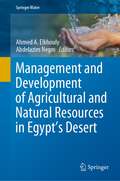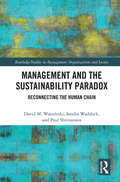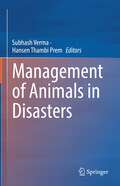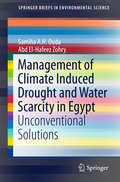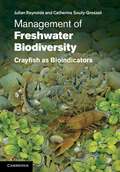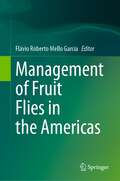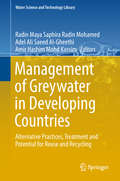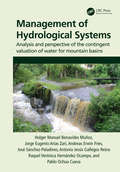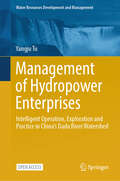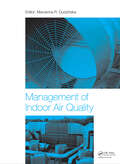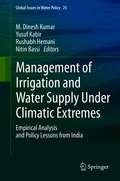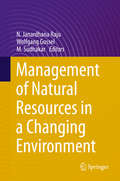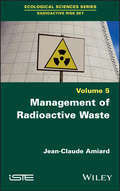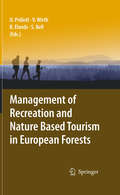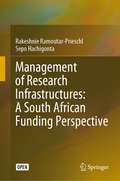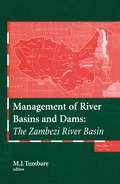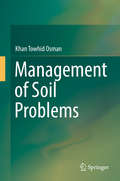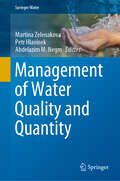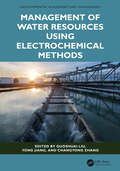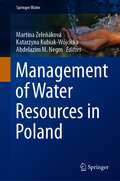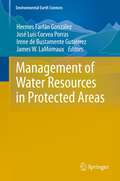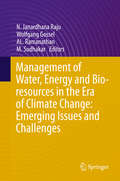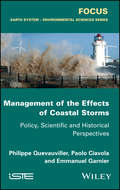- Table View
- List View
Management and Development of Agricultural and Natural Resources in Egypt's Desert (Springer Water)
by Abdelazim Negm Ahmed A. ElkhoulyThis book reviews the economic potential of various natural resources found in the Egyptian deserts that could help fill the food gap in Egypt, e.g., the date palm, olives, and domestic animals. Bearing in mind that the entire country is subject to arid or hyperarid climatic conditions, only a small portion (3% of total area) is agriculturally productive in comparison, the dominant deserts. These aspects, combined with a growing population (ca. 100 million citizens) and water resources scarcity, have produced severe adverse effects on natural resource utilization. This book presents innovative methods for addressing desert soil's key problems (soil erosion, salinity, pollution, decreased fertility, minerals, and weed and pest control). Its goal is to help authorities reclaim the desert and optimally utilize the minerals and the available natural resources to support the sustainability agenda 2030. Besides, it offers researchers guidance on remaining gaps and future research directions. Lastly and importantly, it provides essential information on investment opportunities in desert cultivation, such as the fields of food, fodder, and medicinal plants.
Management and the Sustainability Paradox: Reconnecting the Human Chain (Routledge Studies in Management, Organizations and Society)
by Paul Shrivastava Sandra Waddock David M. WasieleskiManagement and the Sustainability Paradox is about how humans became disconnected from their ecological environment throughout evolutionary history. Begining with the premise that people have competing innate, natural drives linked to survival. Survival can be thought of in the context of long-term genetic propagation of a species, but at the same time, it involves overcoming of immediate adversities. Due to a diverse set of survival challenges facing our ancestors, natural selection often favored short-term solutions, which by consequence, muted the motivations associated with longer-range sustainability values. Managerial decisions and choices mostly adopt a moral calculus of costs versus benefits. Managers invoke economic and corporate growth to justify virtually any action. It is this moral calculus underlying corporate behavior that needs critical examination and reformation. At the heart of it lie deep moral questions that we examine in this book, with the goal of proposing ethical solutions to the paradox. Management and the Sustainability Paradox examines the issue that there appears to be an inherent paradox between what some businesses view as "a need for progress" and " a concern for sustainability". In business, we often see a collision between ideas of progress and sustainability which shapes corporate actions, and managerial decisions. Typical corporate views of progress involve the creation of wealth, jobs, innovative products, and social philanthropic projects. On the basis of these "progressive" actions they justify their inequitable distribution of surpluses by paying low wages and exploiting ecological resources. It is not difficult to see the antagonistic interplay between technological and social innovation with our values for social and environmental well-being and a dualism that needs to be overcome. This book is intended for a broad appeal to an academic and policy maker audience in the sustainability and management fields. The book will be of vital reading for managers seeking to reconnect our human chain with the natural environment in the cause of sustainable business.
Management of Animals in Disasters
by Subhash Verma Hansen Thambi PremThis book is a comprehensive guide for veterinary and humanitarian professionals to plan emergency responses for the care and welfare of animals. It covers various topics on disasters, such as principles of disaster management, operation planning, team deployment, etc., from the perspective of saving both livestock and the livelihood of vulnerable communities. The book also discusses the importance of early warning systems, biosecurity, techniques for data collection, one health approach, climate change, and appropriate mitigation strategies. It highlights different principles, approaches, and guidelines related to the rescue, relief, and management of animals during disasters. It also contains topics on the welfare of birds and the rescue and relief of wild animals. This book includes essential veterinary and life-saving supplies required by the relief providing teams during emergencies such as disasters. The book helps administrators understand the key aspects of welfare and management of animals during disasters and enable them to draft policies focusing on humans and animals’ rescue & welfare and protection of livelihoods. It is an essential guide for veterinarians, humanitarian workers, field functionaries, farmers, disaster response forces personnel, etc., during various types of disasters and emergencies.
Management of Climate Induced Drought and Water Scarcity in Egypt
by Samiha A.H. Ouda Abd El-Hafeez ZohryThe book contains suggestion on suitable crop rotations for salt-affected soils to maximize the productivity of lands and water under current climate and under climate change in 2030. This book discusses droughts and water scarcity, which are important issues related to natural phenomena and affected by climate variability and change. It calls for reassessing the prevailing crop structure in Egypt under rain fed irrigation in North Egypt and under surface irrigation in the Nile Delta and Valley. Droughts affect rain fed agriculture, while water scarcity affects irrigated agriculture. The book investigates proposals for improving crop structure in these areas, taking into account the sustainability of water and soil resources. Further, it explores improved management options for crop production in both rain fed and irrigated agriculture. Lastly, it examines suggestions on more rational use of irrigation water in irrigated agriculture to conserve irrigation water under present climate conditions and to help meet the anticipated demand under climate change conditions.
Management of Freshwater Biodiversity
by Catherine Souty-Grosset Julian ReynoldsIntegrating research into freshwater biodiversity and the role of keystone species, this fascinating book presents freshwater crayfish as representatives of human-exacerbated threats to biodiversity and conservation. It uses examples from these and other large decapod invertebrates to explore how communities function and are controlled, alongside the implications of human demands and conflicts over limited resources, notably the severe impacts on biodiversity. The discussion is structured around three key topics - the present situation of crayfish in world freshwater ecosystems, the applications of science to conservation management and knowledge transfer for successful crayfish management. It outlines the historic exploitation of crayfish, addressing the problems caused by invasive alien forms and explaining the importance of correct identification when dealing with conservation issues. Offering a global perspective on freshwater systems, the book ultimately highlights how the conservation of such large and long-lived species will help protect ecosystem quality in the future.
Management of Freshwater Biodiversity
by Catherine Souty-Grosset Julian Reynolds Keith CrandallIntegrating research into freshwater biodiversity and the role of keystone species, this fascinating book presents freshwater crayfish as representatives of human-exacerbated threats to biodiversity and conservation. It uses examples from these and other large decapod invertebrates to explore how communities function and are controlled, alongside the implications of human demands and conflicts over limited resources, notably the severe impacts on biodiversity. The discussion is structured around three key topics - the present situation of crayfish in world freshwater ecosystems, the applications of science to conservation management and knowledge transfer for successful crayfish management. It outlines the historic exploitation of crayfish, addressing the problems caused by invasive alien forms and explaining the importance of correct identification when dealing with conservation issues. Offering a global perspective on freshwater systems, the book ultimately highlights how the conservation of such large and long-lived species will help protect ecosystem quality in the future.
Management of Fruit Flies in the Americas
by Flávio Roberto Mello GarciaThis book comprises issues at the cutting edge of fruit fly management in the Americas, covering topics that are focal points of current activity and likely long-term importance to the progress of the field. The book is an invaluable source of ideas and inspiration for entomologists at all levels from graduate students to more-established researchers and professionals. Fruit flies (Diptera, Tephritidae) is the most important pests of fruit production worldwide. The purpose of this book is to integrate the experiences of leading scientists in the management of fruit flies in the Americas. In this work, species of fruit flies of economic importance are considered in the genera Anastrepha, Rhagoletis, Bactrocera, and Ceratitis. This book will address fruit flies monitoring, biological control, chemical control, cultural control, sterile insect technique (SIT), Integrated Pest Management (IPM), and other control methods. The book provides invaluable resource material to scientists, professionals and students.
Management of Greywater in Developing Countries: Alternative Practices, Treatment And Potential For Reuse And Recycling (Water Science and Technology Library #87)
by Radin Maya Saphira Radin Mohamed Adel Ali Saeed Al-Gheethi Amir Hashim Mohd KassimThis book reviews the consequences of improper disposal of greywater into the environment and the most appropriate treatment technologies for developing countries, focusing on the potential to reuse greywater as a production medium for biomass and bio-products. It also describes the quantities and qualitative characteristics, as well as the common practice of discharging greywater in developing countries, and highlights the associated health risks. Further, it compares the management of greywater in developed and developing countries and explores the advantages and disadvantages of various treatment technologies, discussing the reuse of greywater for irrigation purposes in arid and sub-arid countries, especially in the Middle East. The book shows the benefits of greywater and introduces low-cost technologies based on the available local facilities can be used to discharge, reuse, and recycle it.
Management of Hydrological Systems: Analysis and perspective of the contingent valuation of water for mountain basins
by Holger Manuel Benavides Muñoz Jorge Eugenio Arias Zari Andreas Erwin Fries José Sánchez-Paladines Antonio Jesús Gallegos Reina Raquel Verónica Hernández Ocampo Pablo Ochoa CuevaThe contingent valuation of water is one of the key components when wanting to implement proposals for integrated water management in mountain basins. Management of Hydrological Systems (MHS), is one of the great challenges that the Sustainable Development Goals (SDGs) currently demand. Mainly in mountain basins with fragile ecosystems that face strong pressures such as poverty, urban and population growth, low water supply and sanitation, and climate change. Management of Hydrological Systems aims for sustainable water management, through contingent water valuation, showing the reader in a didactic way the procedure to follow in mountain basins. This book offers a complete characterization of the main problems affecting this type of basin, as well as the detailed procedure of the contingent valuation of water, which directly involves users. As such, this work is offered in relation to this urgent need for practical guidance demanded by society (SDGs), and is based on practical and real examples, rather than theoretical constructions, from places where these issues have not been widely addressed. The text is recommended as a way forward, not only for water resource managers and decision- and policymakers but also for students and teachers who wish to implement this MHS guide.
Management of Hydropower Enterprises: Intelligent Operation, Exploration and Practice in China’s Dadu River Watershed (Water Resources Development and Management)
by Yangju TuThis open access book highlights the hydropower potential of the Dadu River watershed in Sichuan province, Southwest China, and an important part of the flood control system for the Changjiang (Yangtze) River. Ensuring the safe, scientific, and economical operation of hydropower stations is the basis for sustainable development for hydropower enterprises and is the foremost task during the process of running and managing hydropower enterprises. Because of the special natural, geographical, and cultural environment in the Dadu River watershed, the operation and management of hydropower enterprises face numerous challenges due to complex hydrometeorology, frequent earthquakes and geological hazards, fragile ecological environment, and difficult conditions for production. In order to effectively resolve the many challenges on the Dadu River in terms of reservoir group operational control, power station group power dispatch, operation and inspection of equipment for the whole watershed, operation of multiple power station hydraulic structures, and watershed enterprise management, the multiple power stations in the Dadu River watershed adhere to the concept of innovative development and actively embrace advanced technologies such as cloud computing, big data, Internet of Things (IoT), and artificial intelligence. In 2014, the Dadu River Company was the first in the corporate world to put forward the dream and approach for the construction of the intelligent enterprise, while boldly carrying out exploration and practice in intelligent operations and management in the Dadu River watershed.
Management of Indoor Air Quality
by Marzenna R. DudzińskaDue to changes in lifestyle, people spend more time indoors. This refers not only to the time spent at home and at office premises, but also in shopping malls, recreation centers and transport vehicles. Concentrations of many pollutants are higher indoors than they are outdoors. Consequently, the indoor environment has a bigger impact on human heal
Management of Irrigation and Water Supply Under Climatic Extremes: Empirical Analysis and Policy Lessons from India (Global Issues in Water Policy #25)
by M. Dinesh Kumar Nitin Bassi Yusuf Kabir Rushabh HemaniThis volume provides a theoretical basis for the argument that available research that analyzes the impacts of climate on hydrology, water resources, and water systems, without factoring in the effect of climate variability, are inadequate and often misleading. Also, the book empirically shows that the impacts of climate variability on hydrology and water resources, and irrigation, water supply & sanitation systems are far more pronounced than the likely impacts of future change in climate. The book discusses technological, institutional and policy alternatives for reducing these impacts on various competitive use sectors, especially, irrigation, and water supply and sanitation through case studies of river basins in different hydrological setting.To set the context, the volume first presents the long term trends in precipitation and temperature in different regions of India, and compares them against inter-annual, inter-seasonal and intra-day variations in climatic parameters, to show how their differential impacts on water resources.
Management of Natural Resources in a Changing Environment
by N. Janardhana Raju Wolfgang Gossel M. SudhakarThis book addresses issues related to sources of groundwater pollution such as arsenic, uranium, fluoride and their effects on human health. It discusses extensively the removal of heavy metals, arsenic and fluoride from drinking water. Bioremediation and phyto remediation on biomass productivity are treated in several chapters in the book. The volume highlights leachate characteristics analysed both in the laboratory and in field studies assessing the trace metals in rainwater. This book is a study on the judicious management of natural resources and exposes environmental problems particularly those related to pollution and bioremediation.
Management of Radioactive Waste
by Jean-Claude AmiardThe classification of radioactive waste varies from state to state. This results in different management procedures for each country, while following IAEA and OECD/NEA recommendations.Radioactive waste comes from numerous sources. The largest volumes are generated by the decommissioning and dismantling of nuclear facilities. Long-lived, medium- and high-activity waste – categorized as the most hazardous types of waste – are in fact largely produced by nuclear power reactors, spent fuel reprocessing plants and nuclear accidents.Final disposal of very low-activity, low-activity and very short-lived waste is well controlled. However, final solutions for certain categories, including long-lived waste, sorted waste and spent graphite waste, are not yet in place.Management of Radioactive Waste reviews all the possible solutions and presents those chosen by the various states, including a chapter detailing policy on radioactive waste management, taking France as an example.
Management of Recreation and Nature Based Tourism in European Forests
by Simon Bell Ulrike Pröbstl Birgit H. Elands Veronika WirthThis book provides for the first time a Europe-wide overview on the state of the art of management of recreation and nature tourism in forests. It describes the current situation and conflicts in the different regions of Europe and provides solutions illustrated by good practise examples. It addresses traditions, differences and similarities in European forests as well as new tasks, goals and strategies. The final discussion provides a profound insight into future trends regarding forest recreation and nature based tourism.
Management of Research Infrastructures: A South African Funding Perspective
by Sepo Hachigonta Rakeshnie Ramoutar-PrieschlThis open access book provides an overview of the building blocks necessary for managing, steering and guiding the establishment of a research infrastructure (RI). It offers valuable insights into RI investment, access and management at the academic, grants management, agency and policy level, and serves as a useful guide for the research community, students, and those in the private sector wishing to understand the approaches and opportunities involved in the establishment, maintenance and management of research infrastructure platforms. Presenting a holistic view of RI investment and granting cycles from a South African perspective, the book’s target audience includes those working in science diplomacy, policymaking and science grants councils (especially in Africa) as well as funders and donors.
Management of River Basins and Dams: The Zambezi River Basin
by M. J. TumbareThe Zambezi river basin is the fourth largest river basin in Africa and drains a total of some 1350.000 square km. The basin drains eight countries: Angola, Botswana, Malawi, Mozambique, Namibia, Tanzania, Zambia and Zimbabwe. The river flows over the famous Victoria Falls into the third largest artificial lake in the world: Lake Kariba. The Zambezi Basin is rich in natural resources and has a large hydro-power potential. This volume contains 37 papers which have been published in international journals, or presented at international conferences by the Zambezi River Authority staff. The topics covered include: Dam Safety, Rehabilitation and Maintenance, Environment and Health, Hydrology, Limnology, Information Systems, Water Resource Management, Hydropower Development and Socio-Economic Issues.
Management of Soil Problems
by Khan Towhid OsmanSoils are neither good nor bad, but some have inherent or acquired characteristics that may or may not suit our intended use. Unsuitable characteristics are considered to be soil problems, soil constraints or soil limitations. Only twelve percent of global land is right for agricultural production without much limitation. Some soils have severe limitations for crop production. These soils are so called ‘problem soils’. Many of them do not have enough fertility to be productive; some are arid and saline; some are very sandy and dry; and some are wet and waterlogged for most of the growing season. The global demand for food, wood, fuel, fiber, medicine and other plant products for the 7.2 billion current world population has created such an immense pressure on global soil resources that even the most fertile soils are losing their productive capacity. We are being compelled to bring more and more unsuitable or marginally suitable soils under cultivation. Unless innovative and integrated soil, crop and environmental management practices are adopted for their improvement and sustainable use, further degradation is inevitable. This book, Management of Soil Problems, identifies the problems and discusses management options in a smooth and reader-friendly style. It will be useful for students and professionals of soil science, agriculture, forestry, geography and environmental sciences.
Management of Water Quality and Quantity (Springer Water)
by Petr Hlavínek Abdelazim M. Negm Martina ZelenakovaThis book focuses on water pollution, water management and water structures. Presenting contributions on water quality and quantity issues from the engineering point of view, it discusses a variety of issues, from storm water management in urban areas and water quantity, to hydraulic structures, hydrodynamic modeling and flood protection. The book also provides state-of-the-art insights, which that can be used to effectively solve a variety of problems in integrated water resources management, and introduces the latest research advances. Edited and authored by pioneers in the field who have been at the forefront of water management development in the Czech Republic, this book is a valuable resource for environmental professionals, including scientists and policymakers, interested in water-related issues both in the Czech Republic and elsewhere.
Management of Water Resources Using Electrochemical Methods (Environmental Assessment and Management)
by Yong Jiang Guoshuai Liu Changyong ZhangThis book encompasses various approaches to electrochemical water treatment, emphasizing a well-structured framework within the nexus of electrochemistry, water, and energy. It addresses the urgent challenges of water scarcity and pollution and offers practical insights and operational guidance on removing pollutants and preserving water resources through water purification. Applications and real-life case studies support the innovative nature of electrochemical processes as a sustainable and efficient alternative. The user-friendly approach makes this book accessible to a broad audience, being a specialist seeking advanced techniques or a concerned citizen.Features Covers comprehensively the most recent and advanced electrochemical water treatment techniques. Presents practical operational guidelines and insights. Includes real-world examples and case studies. Focuses on environmental impacts and sustainability. Addresses innovative approaches in technology, theoretical computational analysis, and future development guidance for electrochemical water treatment. This book is for professionals, students, and researchers in water and environmental sciences interested in water treatment, management, and resource recovery. It is also a great resource for public and environmental health experts and readers who work in related disciplines and readers interested in water management, treatment, and the health of the environment.
Management of Water Resources in Poland (Springer Water)
by Martina Zeleňáková Abdelazim M. Negm Katarzyna Kubiak-WójcickaThis book contains a rich resource of essential information on the water resources capacities in Poland. This book contributes to the recognition of water resources management including extreme hydrological events such as floods and droughts. The book incorporates case studies illustrating solutions of water quantity management in Poland. This edited book covers all water bodies in the country including rivers, lakes, reservoirs and groundwater. The novelty of this book is that it represents the first time a manuscript covers the assessment of water resources in Poland, including variability, availability and economic use of the hydrological resources in the country with the lowest renewable resources of surface water per inhabitant in Europe. Given the depth and breadth of its coverage, the book offers engineers, researchers, policy planners, decision makers, and stakeholders essential new insights into efficient water resources management.
Management of Water Resources in Protected Areas
by James W. Lamoreaux Hermes Farfán González Irene de Bustamente Gutiérrez José Luis Corvea PorrasNatural ecosystems are heavily dependent on water, as it is essential to the development of life. The ecology and landscape play an important role in the quality and availability of water. It is no coincidence that exceptional hydrological phenomena are found in protected areas. Such is the case with, for example, the geothermic occurrences (principally, geysers) in America's Yellowstone National Park , the oldest park in the world. The Ramsar wetlands (where the ecosystem's dependency on water is strongly evident), The Iguaçu Falls (on the border of Argentina and Brazil), or the Zapata Swamp (the largest of its kind on the Caribbean island of Cuba) further exemplify this point. However, in many cases, the conservation strategies for hydraulic resources in protected areas are ignored, or simply deprived of the attention they require. There are many types of suitable management strategies for planning and protecting our valuable treasures. Hydraulic resource management in protected areas is something that must not be separated from these conservation measures. The first Symposium for the Management of Hydraulic Resources in Protected Areas was intended to be a framework of communication about experiences with water resource management in protected areas. Advances in research and possible solutions to the problems within these areas were discussed. The contributions in this proceedings volume are grouped under seven main themes: Purification and reuse of wastewater in rural communities; Impact of public use on water resources; Vulnerability and risks associated with aquifers, Design and management water resources in protected areas; Research and monitoring of water resources in protected areas; Water and its importance as a source of renewable energy in protected spaces; and Geodiversity and conservation of areas with hydraulic heritage.
Management of Water, Energy and Bio-resources in the Era of Climate Change: Emerging Issues and Challenges
by N. Janardhana Raju Wolfgang Gossel M. Sudhakar Al. RamanathanGiven our rapidly growing population, the need for judicious management of essential natural resources is becoming a major challenge for planners, managers and scientists/researchers. This book presents a multidisciplinary approach to managing water, energy and bio-resources, described in papers contributed by distinguished scientists and academics working at reputed universities and institutions around the globe. It includes 28 chapters grouped into three sections: Water Resources Management; Energy and Bio-resources Management; and Climate and Natural Resources Management, examining case studies from all over the world. These contributions address current challenges, offering modern techniques for managing these resources in various geographical regions. This volume will provide a valuable asset for researchers and students, managers, environmentalists, hydrologists, water resource and energy managers, governmental and other regulatory bodies dealing with water, energy and bio-resources.
Management of the Effects of Coastal Storms: Policy, Scientific and Historical Perspectives
by Emmanuel Garnier Paolo Ciavola Philippe QuevauvillerThe book will focus on the knowledge base on extreme coastal storms (including storm surges) and include discussions on early warning system for the reliable prediction of morphological impacts due to marine storm events in support of civil protection mitigation strategies. A first part will review the current understanding of the processes generating the events, the morphological evolution of coastlines during and after the events, the methods for monitoring the process as it occurs or for post-event appraisal. A second part will provide insight into the policy framework related to coastal storms (and flooding), and a third part will describe the Xynthia case study.
Managementwissen für Naturwissenschaftler und Ingenieure
by Olaf E. KrausManagementwissen wird nicht nur in Wirtschaft und Industrie, sondern auch in der Forschung und bei Behörden mehr denn je vorausgesetzt. Diese Anforderung trifft Ingenieure und Naturwissenschaftler oft unvorbereitet. Das Buch ist in dieser Situation ein unentbehrlicher Ratgeber - ob beim Berufseinstieg, der Existenzgründung oder dem Karrieresprung. Für die Neuauflage konnte der Herausgeber neue Autoren aus dem ingenieurs- und wirtschaftswissenschaftlichen Bereich gewinnen. Der Schwerpunkt der Darstellung liegt auf Vorgehensweisen im Managementalltag.
